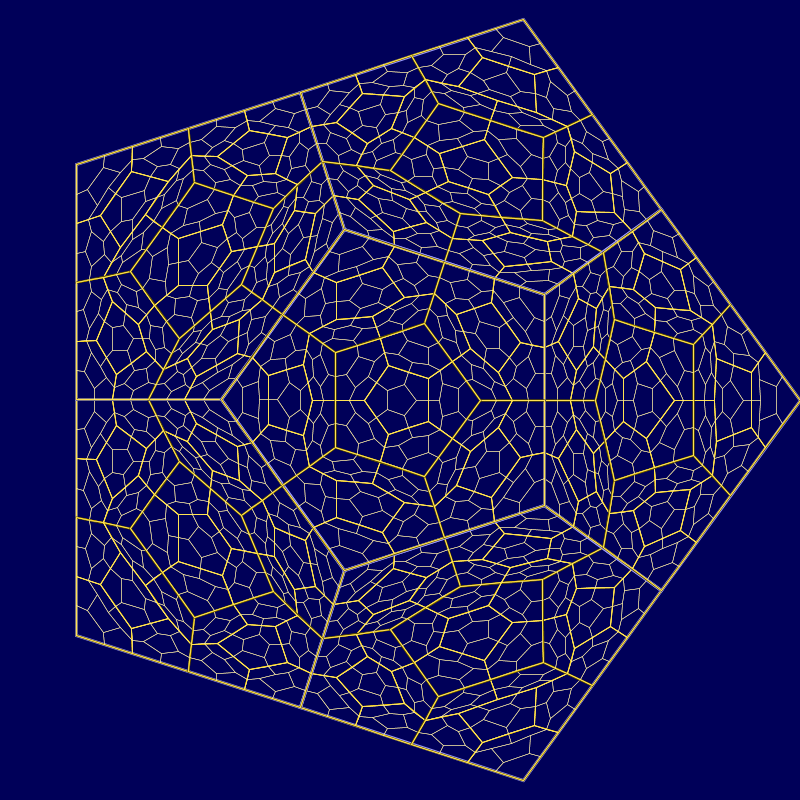Sutcliffe Pentagon is it a thing?
Recently suzy on the processing forum was asking how to create a Sutcliffe pentagon, this got me thinking is there such a thing. So far the only reference I have found to it, was in an extract of Matt Pearsons Book Generative Art book. Anyway it looked interesting so I had go at coding it in JRubyArt (using some logic from a recursive pentagon sketch by C. Andrews on openprocessing). The sketch features a couple of nifty JRubyArt features including Vec2D (whose methods can be chained, and just look like math) DegLUT tables, and a handy way of creating an enumerable colour palette from an array of web strings. The other quite useful feature (missing in vanilla processing) is the ability to create a vertex directly from the vector.
sutcliffe.rb
# Sutcliffe Pentagons (a JRubyArt Sketch by Martin Prout)
load_library :color_group
attr_reader :strut_factor, :renderer, :cols
PALETTE = %w[#fff0a5 #ffd500 #594a00 #9999ff #000059].freeze
def setup
sketch_title 'Recursive Pentagons'
@strut_factor = 0.2
@renderer = AppRender.new self # so we can send Vec2D :to_vertex
group = ColorGroup.from_web_array(PALETTE.to_java(:string))
@cols = group.colors
background(cols.last)
no_loop
end
def draw
translate(width / 2, height / 2)
angle = TWO_PI / 5
radius = width / 2
points = (0...5).map do |i|
x = radius * cos(angle * i)
y = radius * sin(angle * i)
Vec2D.new(x, y)
end
fractal = Pentagon.new(points, 4)
fractal.draw
save_frame(data_path('sutcliffe.png'))
end
def settings
size(800, 800)
end
# Here we include Processing::Proxy to mimic vanilla processing inner class
# access.
class Pentagon
include Processing::Proxy
attr_reader :points ,:branches, :level, :midpoints, :innerpoints
def initialize(points, levels)
@points = points
@level = levels
return if level.zero? # so called guard clause in ruby simplifies code
# find the midpoints on each edge
@midpoints = (0...5).map do |i|
midpoint(points[i], points[(i + 1) % 5])
end
# find the inner points
@innerpoints = (0...5).map do |i|
opposite = points[(i + 3) % 5]
x = midpoints[i].x + (opposite.x - midpoints[i].x) * strut_factor
y = midpoints[i].y + (opposite.y - midpoints[i].y) * strut_factor
Vec2D.new(x, y)
end
# Create the Pentagon objects representing the six inner
# pentagons (`logic stolen from C. Andrews`)
# the shape is very regular, so we can build the ring of five
@branches = (0...5).map do |i|
p = [
midpoints[i],
innerpoints[i],
innerpoints[(i + 1) % 5],
midpoints[(i + 1) % 5],
points[(i + 1) % 5]
]
Pentagon.new(p, level - 1)
end
# add the final innermost pentagon
branches << Pentagon.new(innerpoints, level - 1)
end
# This is a simple helper function that takes in two points (as Vec2D) and
# returns the midpoint between them as Vec2D.
def midpoint(point1, point2)
(point2 + point1) * 0.5
end
# This draws the fractal. If this is on level 0, we just draw the
# pentagon formed by the points. When not level 0, iterate through the
# six branches and tell them to draw themselves.
def draw
no_fill
begin_shape
stroke_weight level
stroke cols[level]
points.each do |point|
point.to_vertex(renderer)
end
end_shape CLOSE
return if level.zero?
branches.each(&:draw)
end
end
